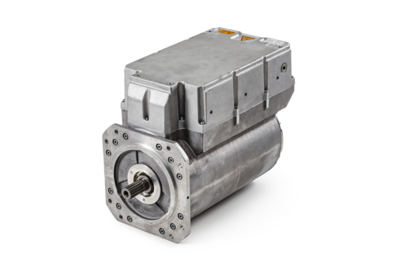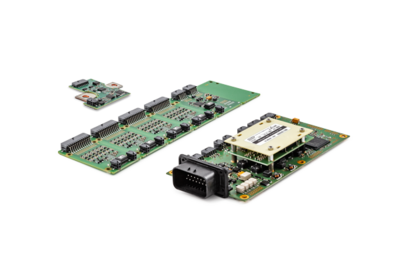The market for transportation systems is currently experiencing a phase of upheaval. Due to changes in the ecological, political and legislative framework conditions, new solutions are becoming increasingly significant. E-mobility provides alternatives for goods transportation and is becoming more and more suitable for everyday use: Battery-operated trucks are receiving road approvals ready for series production; goods are to be transported cleanly and quietly. In the same way, logistics experts are looking for high power capacities and flexible possibilities for operation whilst at the same time lowering the operating costs. An electrically-powered truck unites all these factors. The necessary step towards a mainly CO2-free supply chain is thus slowly coming within reach.
FRAMO presents a fully-electric truck construction series.
FRAMO GmbH from Langenberndsdorf near Zwickau started in 2016 with the production of battery-electric commercial vehicles with a permitted total mass from 7.5 to 44 tonnes. The vehicles, each of which is mounted onto a MAN chassis, are based on a modular drive and battery concept. Here all the conventional superstructures such as flatbeds, trunks, refrigerated bodies, refuse collection vehicles, swap bodies and skip loaders or semi-trailer combinations are possible. Basically, the e-truck can be used in all areas as a commercial vehicle.
FRAMO was a Saxonian automotive brand which from 1927 manufactured small vans, and later also small cars. Now the FRAMO brand is to be revived through an e-truck. Managing Director Andy Illgen is advertising the e-truck under the slogan “Decarbon your business”! FRAMO GmbH has set itself the objective of making a major contribution towards the path-breaking and urgently required electrification of local traffic logistics in goods transportation. Local emission-free logistics substantially reduce the noise and air pollution in inner city operations. The battery-electric truck is used in distribution operations over short distances or for internal plant traffic. Here, for example, the entire supply chain can be optimised, which in turn promises a positive CO2 footprint.
100 % electrically-operated commercial vehicles open up completely new possibilities such as night traffic in traffic-restricted zones, and driving in precarious air quality situations and under limit and target value exceedances in metropolitan areas. The application areas for battery-electric trucks are urban and suburban spaces and plant logistics. This also provides an opportunity to create new logistics concepts. For example, the e-truck can take over the fine distribution of goods into the city in 7-day, 24-hour operation as a low-noise and emission-free shuttle transport from goods centres (“hubs”).Various studies have revealed that already one third of heavy goods vehicles in conurbations today travel short distances. This third could already be replaced through low-emission vehicles, which thus opens up extremely high potential through the use of electric vehicles.
Some examples of application cases are:
- Local distribution traffic with electric trucks in partial load and piece goods transportation
- Shuttle transportation from a distribution centre on e-trucks for the “last mile”
- The use of electric tractor units in the pre-run and post-run of combined transportation
Like no other vehicles, electric vehicles are suitable for the flexible and modular assembly of components such as those from battery storage devices, prime movers/drive units and charging systems. These can be configured exactly according to the customer’s requirements regarding power and range, thus guaranteeing the relief of resources during production and daily operations. Vehicle operators of battery-electric vehicles drive more carefully, as they utilise the negative acceleration energy during recuperation for energy recovery and thus contribute towards increasing the range using the available driving intelligence. In the same way, a palpable reduction in the use of conventional brakes in operation has been verified, which in turn avoids the development of fine dust and increases the lifetime of the vehicles. The exact dimensioning of the vehicles for the ranges and performance requirements of the users has a positive effect on the TCO value (total cost of ownership) of the e-truck. Through this multitude of new possibilities, the vehicles amortise themselves extremely quickly depending on the application field. The young company has an experienced partner in the Service and Sales area at its side with the truck rental company BFS. BFS, with more than 70 partners, is the leading rental company for special commercial vehicles in Germany and Switzerland.
Motorisation
Customers are able to select from various electric motorisations from 80 kW to 420 kW. Through the modular approach, the drive can be dimensioned according to requirements on the route profile. Here the selected vehicle with the required useful load is decisive, and the gradeability necessary for this purpose. At this point, Sensor-Technik Wiedemann GmbH (STW) comes into play as the system supplier for the drive. STW develops and produces components for successful electrification used both in commercial vehicles and in construction and agricultural machinery. During the development and manufacture of the solutions, STW relies on its know-how, its technology and its infrastructure, which permit both small quantities and series production.
The drive package
At the heart of this package is the powerMELA C drive units, which drive into the axle via a summation gearbox. The modular drive package from 80 to 420kW sets new standards with regard to compactness and performance weight. Through the integration of the converter to the motor housing, an enclosed unit is created which also renders the erection of a central control cabinet superfluous and thus reduces the installation effort required. No wiring whatsoever is required between the converter and motor. With a Protection IP6k9k and a protection-insulated structure, the powerMELA C-motor is perfectly equipped for mobile applications.
The permanently excited synchronous motor features the highest degree of effectiveness in comparison to other motor technologies. The minimisation of the losses is also achieved through the optimum dimensioning and alignment of the motor, electronics and control system. This includes the adaptation of the performance data for the electronics and motor and the optimised control. These take place in the powerMELA C series through a field-oriented control system using the MTPA (Maximum Torque Per Ampere) procedure. Here, in addition to the Lorentz force of the permanent magnets, the reluctance torque of the motor is used, and thus the motor current is minimized. An adaptive control system, which takes changes in the motor parameters into account during operation, also contributes towards a higher degree of efficiency. Through the integration of the field weakening mode, the speed range is extended by a factor of 2 to 6000 rpm. In this operating range, the full power is made available independent of the speed.
Battery storage devices
As a battery storage device, capacities of 57 to 318 kWh are available. Through the use of long-lasting lithium NMC cells, up to 9000 load cycles @ 100% DoD are expected, which, depending on the battery capacity, accords with a running performance of well over 1.0 million km. This is however significantly dependent on the operating times or the charging and discharging rates, and is influenced by further factors. Here FRAMO relies in particular on a thermally-installed housing, an integrated HV distribution and a CCS charging interface for DC fast charging and AC on-board charging. The safe management of the high-voltage battery is organised by the STW-powerMELA mBMS.
Safe management of the high-voltage battery
With its mBMS system, STW brings with it a complete modular system of hardware and software components for the realisation of a safe management system for high-voltage batteries. The sensor components within the storage device serve the measurement and monitoring of individual cell voltages and temperatures, currents and the determination of the insulation conditions. The dynamics, performance and efficiency of the electric batteries depend on the state of charge (SOC), the state of health (SOH) and the temperature of the respective battery. These safety functions are an important component of the Battery Management System (BMS). Their implementation is subject to the applicable regulations and productions for functionally-safe systems as determined in the IEC 61508 Standard and the application-specific standards derived from it.
The redundant high-precision BMS contains measuring devices for individual cell voltages and cell temperatures. Each battery has two contactors, which permit two-pole connection and disconnection of the respective battery. These contactors are supplemented by a high-precision, shunt-based current measurement and insulation monitoring, and a pre-charging unit for the controlled charging of the intermediate circuit capacity. In addition, the BMS features a 32-bit microcontroller. Its software is decoupled from the functionally-safe components and conducts more complex algorithms for determining the condition (current power capacity, SOC and SOH) of the battery.
As storage device sizes increase, parallel connection, not only of cells, but also of whole storage device lines, is increasing in importance. During parallel operation, a BMS can be assigned a master function. This BMS then takes over the coordination and gives the energy storage system the appearance of one single battery with appropriately high capacity. This means that high modularity can be achieved depending on the required range.
Energy management
The control of the drive package takes place using an ESX control unit by STW, which has been programmed with a software by CuroCon. The control device CuroControlSRx offers integrated safety functionalities and the integration of different operating strategies. Through recuperation, energy can be regained in the braking process and returned into the existing storage system. In the same way, these vehicles can be charged via the existing energy infrastructure. For this purpose, FRAMO offers different DC – CCS quick charging stations with charging capacities of up to150 kW. The charging controller manages the interfaces. The driving functionality is comparable with conventional vehicles. As usual, the following driver assistance systems are offered: the electronic stability program (ESP), the electronic braking system (EBS), the anti-blocking system (ABS), the emergency braking assistant (EBA), the emergency braking signal (ESS), the lane guard system (LGS) and a digital tachograph. Optionally, the air conditioning systems with permanent cooling function and electric heating with preheating system can be selected. A cruise control is also available.
In addition, travelling with an electric drive is pure enjoyment as far as acceleration and running smoothness are concerned. Here electrical systems are able to display their full bandwidth of advantages, which offer wonderful driving characteristics depending on the motorisation. The baptism of fire was passed with flying colours at the largest E-Mobile-Rally Tour at the 6th WAVE “Let’s move the world". Here approximately 1800 km were covered by one of the first vehicles as a service and support vehicle. The first model was presented to the market at the IAA-Nutzfahrzeuge (Commercial Vehicles trade fair) last September in Hannover. Electromotive applications are establishing themselves in many economic areas, in part due to public interest and the appropriate promotion, and in part due to considerations made by the companies themselves and imposed regulatory obligations. FRAMO and STW have spotted the increasing requirements in electric delivery transportation, and will in future be putting more e-power onto the roads in successful operations.



